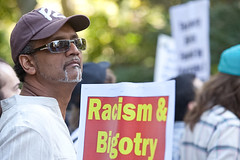Below is the last (for now) post from our guest blogger, Nathan Palmer. Nathan’s work can be followed at www.sociologysource.com.
Does race still matter? This is my day one question for students in my race & ethnicity courses. Many students walk into my class on the first day thinking that racism, prejudice, and discrimination are issues that were solved in the 1960s. Frequently I hear, “”well things aren’t perfect, but they sure are getting better all the time.” Countless students have said to me, “How much racism can there be if we have a Black president?” While I see this line of thinking more often from my white students, I have had many students of color share this mindset. Using very recent current events can convince students that racism is not a thing of the past but a very real part of our present.
Even students who believe and know that racism is alive and well are typically unaware of the numerous current events that many feel are clear examples of racism. Students are surprised to hear that just this August a Mississippi middle school barred students of color from running for class president. Most students have not heard about the controversy surrounding the firing of Shirley Sherrod over claims of racism. Students are unaware that two ROTC students spread cotton in front of the Black Culture Center at the University of Missouri in February. They are shocked to learn that, also during this past February, a student hung a noose in the UC San Diego library and shortly thereafter a UCSD fraternity put on a “ghetto themed” party called the “Compton Cookout” where guests were invited to dress like thugs and “Nappy Headed Hoes.” I tell my students that this is by no means an exhaustive list. You could also discuss the recent Arizona Immigration laws, or the recent controversy over “Dr. Laura” using the N-Word multiple times on air.
As we go through each of these news events and facts I say over and over again that I am not saying each of these events is evidence of racism. I am simply showing them examples of what others have called racism. This is crucial, because it avoids any debate about the incidents and it keeps students from feeling bullied or steamrolled. Also, students are savvy enough to draw their own conclusions.
I wrap up the discussion by asking my class, “If racism is a thing of the past, why is it in the news so frequently?” “If we have civil rights laws on the books and a Black president, why do we continue to talk about the dead issue of racism?” Needless to say, my students always seem to see the ridiculousness of these questions.

